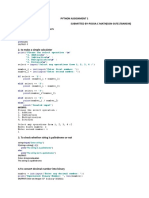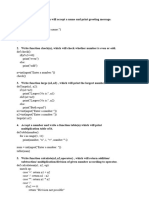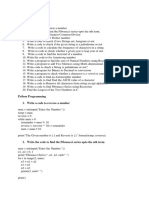0% found this document useful (0 votes)
8 views3 pagesPython 3
The document contains a series of Python functions that demonstrate various programming concepts. These include calculating Fibonacci numbers, digit sums, reversing strings, swapping values, finding the maximum of three numbers, calculating the area of a circle, and merging two lists. Each function is accompanied by user input prompts and outputs for demonstration.
Uploaded by
magarratna471Copyright
© © All Rights Reserved
We take content rights seriously. If you suspect this is your content, claim it here.
Available Formats
Download as DOCX, PDF, TXT or read online on Scribd
0% found this document useful (0 votes)
8 views3 pagesPython 3
The document contains a series of Python functions that demonstrate various programming concepts. These include calculating Fibonacci numbers, digit sums, reversing strings, swapping values, finding the maximum of three numbers, calculating the area of a circle, and merging two lists. Each function is accompanied by user input prompts and outputs for demonstration.
Uploaded by
magarratna471Copyright
© © All Rights Reserved
We take content rights seriously. If you suspect this is your content, claim it here.
Available Formats
Download as DOCX, PDF, TXT or read online on Scribd
/ 3

































































